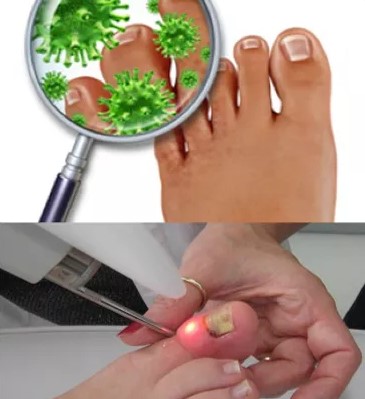Fungal infection of the nail
Onychomycosis (also called tinea unguium) is a fungal infection that affects the nails. Fungal infections normally develop over time, so any immediate difference in the way your nail looks or feels may be too subtle to notice at first.
Although many of the causes of onychomycosis are preventable, some risk factors increase the likelihood of developing it.
You are more likely to develop a fungal nail infection if you:
have diabetes
have a disease that affects the blood vessels
are an older woman
wear artificial nails
swim in a public swimming pool
have a nail injury
have moist fingers or toes for an extended time
have a weakened immune system
wear closed shoes, such as tennis shoes or boots
A fungal nail infection occurs from the overgrowth of fungi in, under, or on the nail. Fungi thrive in warm, moist environments, so this type of environment can cause them to naturally overpopulate. The same fungi that cause athlete’s foot, and skin fungus can cause infection in the nails.
Fungi that are already present in or on your body can cause nail infections. If you have come in contact with someone else who has a fungal infection, it may have spread to you.
If you get a manicure or pedicure at a nail salon, be sure to ask how and how often the staff disinfects their tools. Tools, such as emery boards and nail clippers, can spread fungal infections from person to person if they are not sanitized.
Visible Signs
Visible fungal nail infection signs include: scaling under the nail OR white or yellow streak on the nail OR crumbling corner or tip of the nail OR flaking white areas on the nail’s surface OR yellow spots at the bottom of the nail OR loss of the nail.
How to treat it ?
Oral antifungal medication, such as:
a. terbinafine
b. itraconazole
c. fluconazole
d. Griseofulvin
You may use other antifungal treatments, such as antifungal nail lacquer or topical solutions. These treatments are brushed onto the nail in the same way that one would apply nail polish from 3-9 months according to the case. Taking good care of your nails by keeping them well trimmed and clean is a good way to prevent infections from taking root. You should also avoid injuring the skin around your nails.
Nd: YAG Laser helps to destruct the fungus infection (1-3 sessions according to the severity of the case) by using special parameter after numbing the nail and skin around by Local anesthesia or anesthetic injection (Lidocaine).

